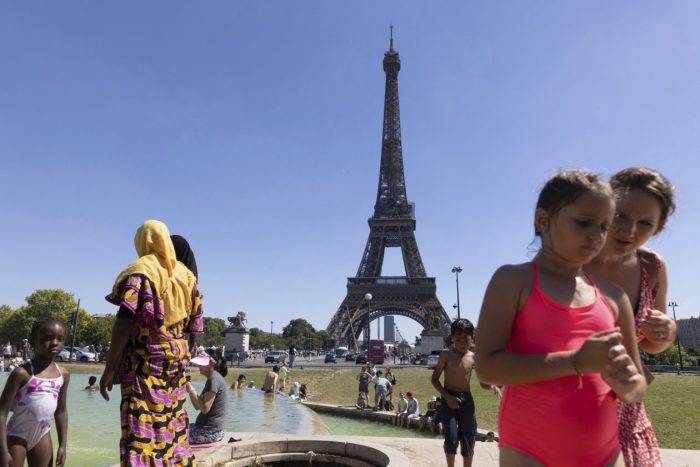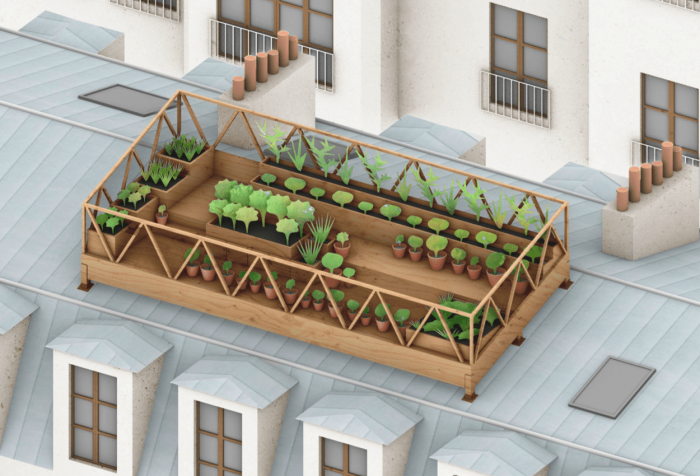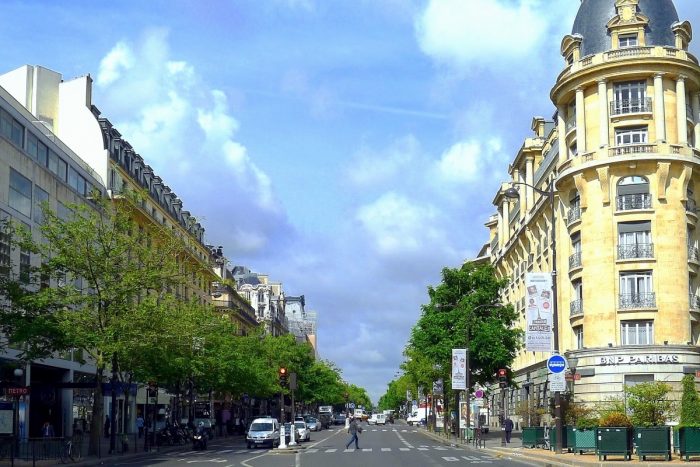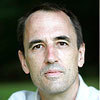
There’s a long tradition in France of taking August off for holiday. Paris virtually shuts down as the temperature drifts around in the seventies, and people go to the beach or the mountains to cool off and relax. Think of it as an old‑fashioned adaptation to heat. People who stick around during August are often older or have jobs that require them to stay and keep the city functioning.
In the summer of 2003, Parisians who remained in the city were hit with something they were not accustomed to: a heat wave. For nine days in August, the daytime temperature was above 95 degrees Fahrenheit (35 degrees Celsius), sometimes spiking up to 104 degrees F (40 degrees C). It didn’t cool off much at night either. It took a few days for the full scope of the tragedy to reveal itself. Hospital emergency rooms started to fill up. A week or so into the heat wave, city officials began running out of places to store bodies.
In less than two weeks, 15,000 people in France died as a direct result of the heat wave. Nearly a thousand lived in central Paris. Many of the victims lived alone, in top‑floor garrets or attic apartments, where the heat built up beneath zinc roofs and literally cooked people as if they were in an oven.
Building for change
Like every other city in the world, Paris was built by people who believed that the Earth’s climate was stable. Yes, there were hot and cold days, ebbs and flows of rivers, storms, and droughts, but the basic idea that there was a certain steady state and that the world would always return to it was never questioned. Just as no one built a city on the coast with the assumption that the polar ice sheets could melt and raise the water five or six feet in a few decades, no one built a city with the assumption that the temperature would jump five or 10 degrees Fahrenheit or that extreme heat waves would zap us. We built and lived in the Goldilocks Zone, and our cities are a part of that. They are Goldilocks cities.
But now, like everything else, these cities have to change. That is being brought home this month, as Earth has seen its hottest days on record, and deadly heat waves have hit the U.S. Southwest, Southern Europe, China, India, and elsewhere. Making a city that was not designed for extreme heat into a city that is livable during extreme heat is the great urban engineering project of our time. Or, if that is too much, at least making it a city that is not a death trap for its citizens.
For cities, the challenge of thriving on a superheated planet is twofold. First, as cities grow, how do you ensure that they grow in a heat‑smart way? Another 50 years of suburban sprawl is not the answer. Cities need to be denser. Cars need to be replaced with bikes and public transit. New buildings need to be not only efficient and built of sustainable materials, but also safe for people during increasingly intense heat waves. That means more green space, more trees, more water, more shade, more thermally intelligent urban design.

The second, and more difficult, challenge is figuring out what to do with existing buildings and cityscapes. The vast majority of existing buildings are ill‑suited for the extreme climate of the 21st century: poorly insulated, poorly sited, dependent on air-conditioning to keep them habitable. Do you tear them down and rebuild? Do you retrofit? How do you create more green space in already crowded inner cities?
Current solutions
In many cities, this urban remodeling project is already underway. In New York City, workers and volunteers have planted over a million trees to add shade and clean the air. In Seville, Spain, city planners are using the technology of ancient underground waterways to provide cooling for the city without depending on air‑conditioning. In Freetown, Sierra Leone, officials are creating urban gardens, improving access to clean water, and erecting plexiglass awnings over outdoor markets. In Los Angeles, public works crews are painting streets white to increase reflectivity. In India, they are experimenting with green roofs, which absorb heat and create space to grow food.
But perhaps nowhere in the world do the challenges, as well as the opportunities, loom larger than in Paris, where nearly 80 percent of the buildings have zinc roofs—an affordable, corrosion-resistant and virtually inflammable innovation of the 19th century. But those roofs are, in the 21st century, deadly—heating up to 194 degrees F (90 degrees C) on a summer day. And because top‑floor garrets were not insulated, that heat is transferred directly into the rooms below.
What’s to be done? Adding insulation under the zinc would be very expensive. Painting the roofs white could help. Light colors increase the albedo, or reflectivity, of buildings, deflecting sunlight and causing less heat to be absorbed. White roofs can be remarkably effective in sunny climates. Researchers at Australia’s University of New South Wales determined that white roofs reduced indoor temperatures by up to 7 degrees F (4 degrees C). But since the zinc roofs in Paris are already light‑colored, the impact would be more modest.
Green roofs are another possibility. In 2020, three young Parisians founded a company called Roofscapes to build what amounts to wooden platforms that rest on load-bearing walls and sit atop the zinc roofs, which could become rooftop terraces. “People can grow food and get protection from the heat at the same time,” said Olivier Faber, one of the co-founders of the company. Paris officials have no problem with green roofs on new buildings—in fact, the city recently passed a law requiring them (or solar panels) on all new commercial structures above a certain size. It’s the old buildings that are the problem.
The role of trees
The cooling of Paris began in 2014, with the election of Anne Hidalgo as mayor. After closing several roadways and building bike lanes—not without controversy—she pivoted from cars to trees. Despite Paris’s many parks, the city has one of the lowest tree canopy covers of any city in the world—only 9 percent, compared with 27 percent in Boston and 29 percent in Oslo. In the summer of 2019, Hidalgo launched an urban forest campaign, vowing to “significantly green” schoolyards around the city as well as four emblematic sites: the Hôtel de Ville, the Gare de Lyon, the square behind the Opéra, and a lane on the banks of the Seine.

Trees are superheroes of the climate fight. They inhale CO2 and exhale oxygen, filtering out air pollution with each breath. They suck up water from the ground and sweat it out through their leaves, which cools the air. And of course they provide shade to all creatures great and small, as well as to the soil around them, which helps to reduce water loss through evaporation.
As part of Hidalgo’s urban forest initiative, the city plans to plant 170,000 new trees by 2026. That may sound like a lot, but let’s put it into perspective. New York City has planted over a million trees and is still going. Milan’s urban forest project is planting 300,000 trees a year, with a goal of 3 million new trees in the city by 2030. Just to give a sense of what this means on a global scale, there are about 3 trillion trees on the planet, which works out to about 422 trees for every person on Earth. Humans are responsible for the loss of 15 billion trees a year. About five billion new trees are planted or sprout annually, yielding a net loss each year of 10 billion trees. So as much as people may love trees, in the big picture, we are not very good to them. Since the beginning of human civilization, the number of trees on the planet has dropped by 46 percent.
Still, 170,000 trees are 170,000 trees. And when it comes to cooling off a city, trees matter. During the summer of 2022, one researcher found that on a hot afternoon the temperature on the ground in front of the Paris Opera House measured 133 degrees F (56 degrees C). A few steps away, under the shade of the trees on Boulevard des Italiens, the temperature on the sidewalk was only 82 degrees F (28 degrees C).
Not a be-all solution
But in a rapidly changing climate, trees are not a simple answer to urban heat. For one thing, it’s much easier to plant a tree than to keep it alive. In Los Angeles, city officials estimate that it costs $4,351.12 to plant and maintain a single oak tree for five years. Then there is the question of who’s responsible for maintaining them. According to one tree advocate in Phoenix, the average life expectancy for a street tree in that city is only seven years.
Even when they are properly cared for, city trees have a tough life. Dogs pee on them. Their roots are covered by asphalt and concrete. Lovers carve their initials into their bark. Drunk drivers run into them. In Athens, an invasive beetle is decimating the mulberry trees that provide shade in public squares. Ash trees, which make up the majority of shade trees in U.S. cities like Chicago and Milwaukee, have been wiped out by the emerald ash borer, an Asian jewel beetle that arrived in North America in the early 2000s.
Deciding which trees to plant is not a simple matter either. To protect against widespread losses from disease and invasive species, diversity is important. But the climate of cities today will not be the climate of cities in 2050. Arborists and urban planners find themselves casting forward, looking at which trees might be best suited to future conditions. In central Paris, the ubiquitous London plane trees are goners, vulnerable in a warming climate, and are being replaced by evergreens, oak, and buckeye. In Tucson, palm trees are out, and paloverde and mesquite are in.

Additional measures
The centerpiece of the remaking of Paris is the Champs‑Élysées, the once-grand boulevard that runs between the Arc de Triomphe and the Place de la Concorde. In keeping with Hidalgo’s vision of a cooler, greener city, architects with the French firm PCA-Stream have developed a plan to eliminate several lanes of traffic to make room for bike lanes and broader pedestrian paths. The black asphalt would be removed and replaced with a lighter‑color paving that would reflect sunlight. Rainwater would be captured and recycled. And more than a thousand trees would be planted in open soil that allows tree roots to mingle. Besides making the Champs‑Élysées safer, greener, and more fun to visit, the architects estimate the makeover would lower the area’s sidewalk temperature by more than 7 degrees F (4 degrees C).
Of course, all this retrofitting, and other large public works, will take an enormous amount of time and money, to say nothing of stable political leadership and consensus among stakeholders, many of whom would prefer to see no change at all. As Phillipe Chiambaretta, the co-founder of PCA-Stream, told me, “What will get built, how far we will be able to go with this, I don’t know yet. We can save the future, or we can save the past, but we can’t do both.”
Franck Lirzin, who worked as an advisor to the French government during the 2003 heat wave and wrote an influential book about how Paris can adapt to climate change, fears that rules and laws will make it impossibly difficult to modify historic buildings in the center of the city. “Because the heat is not going to stop soon, people will have to do something,” Lirzin says. “And what they will probably do is the same thing that people are doing all over the world—buy an air conditioner and stick it in the window. And for Paris, that would be a disaster. It would increase the demand on the gird, which would increase the risk of blackouts. And it would be ugly.”
There are other ways to cool off Paris. Lirzin points out that many public buildings already use a district cooling system, which circulates water chilled by being underground through pipes in the building. The system could be expanded to include other parts of Paris, as well as private homes.
Buildings could also be retrofitted so they don’t need artificial cooling at all. One French architecture firm took 530 apartments in an ugly, inefficient concrete government housing building in Bordeaux and transformed them into bright, airy, well‑ventilated dwellings. And they did it cheaply, and without displacing any residents. Why not scale the idea up and retrofit every old building in Paris?

Looking ahead
Alexandre Florentin, a Paris city council member, is part of a growing number of young Parisians who see extreme heat as a mortal threat to the City of Light. It’s not just the zinc roofs, he said. It’s the fact that schools aren’t insulated or air‑conditioned, hospitals are poorly built for heat, and the vast majority of Parisians in his district are uneducated about how to handle heat. Florentin fears the city is headed for an apocalyptic future: summer blackouts, overrun emergency rooms, food shortages, epic traffic jams as people escape the city, firefighters dying of heatstroke as they fight wildfires in the Bois de Vincennes, Paris’s largest public park. “We have entered a new climate and energy paradigm,” Florentin argued. “We need a social and cultural transformation on a level that I’m afraid people who have been in power for the last 20 years cannot really imagine.”
The status quo is not an option. One way or another, Paris—like every other city in the mid‑latitudes—is going to be reshaped by extreme heat just as surely as it has been reshaped over the centuries by war and disease and commerce. Florentin pushed the city council to establish a 15‑member commission called “Paris at 50°C,” which will hold public meetings around the city and make recommendations to the full council about the best strategies to adapt to extreme heat. “Here in Paris, there are three options,” Florentin said bluntly. “We roast, we flee, or we act.”
Adapted from The Heat Will Kill You First: Life and Death on a Scorched Planet by Jeff Goodell, with permission of Little, Brown and Company. Copyright © 2023 by Jeff Goodell.
Jeff Goodell’s new book is The Heat Will Kill You First: Life and Death on a Scorched Planet. Previous books include The Water Will Come, How to Cool the Planet, Big Coal, and Sunnyvale, a memoir about growing up in Silicon Valley. A contributing editor at Rolling Stone, his work has appeared in The New Republic, The Washington Post, The New York Times Magazine, and Wired. This article was originally published in Yale Environment 360.
Weekly Newsletter
Get building science and energy efficiency advice, plus special offers, in your inbox.














0 Comments
Log in or create an account to post a comment.
Sign up Log in